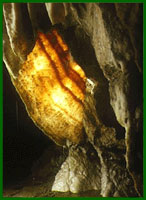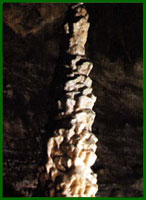
 |
|
| |
The National Showcaves - Dan Yr Ogof
Geology
 The
caves at Dan-yr-Ogof are made of carboniferous limestone, formed some
315 million years ago, when the area that is now the National Showcaves
Centre for Wales lay to the south of the equator and was covered by a
warm shallow tropical sea. Shellfish corals and numerous small creatures
lived in these waters. When they died their shells and skeletons sank
to the sea floor. They were the source of calcium carbonate, the raw material
for limestone rock. Over millions of years these calcium carbonate muds
and sands have been deeply buried and transformed into limestones. The
continents have moved around and mountain chains have been built and eroded.
The end result is that Dan yr Ogof is now in the temperate belt of the
northern hemisphere, thousands of mile from where its limestone originated.
The
caves at Dan-yr-Ogof are made of carboniferous limestone, formed some
315 million years ago, when the area that is now the National Showcaves
Centre for Wales lay to the south of the equator and was covered by a
warm shallow tropical sea. Shellfish corals and numerous small creatures
lived in these waters. When they died their shells and skeletons sank
to the sea floor. They were the source of calcium carbonate, the raw material
for limestone rock. Over millions of years these calcium carbonate muds
and sands have been deeply buried and transformed into limestones. The
continents have moved around and mountain chains have been built and eroded.
The end result is that Dan yr Ogof is now in the temperate belt of the
northern hemisphere, thousands of mile from where its limestone originated.
About 5 million years ago, during and following the development of the Alps, Dan yr Ogof was in a relatively gentle backwater. Features of the present landscape could be recognised. The sea level was about 200 metres higher than at present. The riverbeds were therefore higher than at present. Caves were forming at these levels.
 Then
about 2 million years ago the Ice Ages started. Polar ice caps and glaciations
in the mountainous regions locked up vast quantities of water on land.
This reduced the water in the sea and sea levels fell. The rivers responded
by cutting into their beds, thus forming gorges and waterfalls. The rivers
running underground in the caves cut new passages at lower levels and
abandoned the higher levels. Cathedral cave is an abandoned higher level.
The show cave of Dan yr Ogof is formed in one of these lower levels and
the river is still cutting its way down to form even lower cave passages.
Then
about 2 million years ago the Ice Ages started. Polar ice caps and glaciations
in the mountainous regions locked up vast quantities of water on land.
This reduced the water in the sea and sea levels fell. The rivers responded
by cutting into their beds, thus forming gorges and waterfalls. The rivers
running underground in the caves cut new passages at lower levels and
abandoned the higher levels. Cathedral cave is an abandoned higher level.
The show cave of Dan yr Ogof is formed in one of these lower levels and
the river is still cutting its way down to form even lower cave passages.
Some 800,000 years ago the climate became much colder with heavy snowfalls and the development of ice fields on high ground and glaciers in the valleys. The cold spells were interspersed with relatively warmer periods, in one of which we are currently living. The effects on the cave were important as glacial debris filled by floodwaters when the ice melted. The ice came and went and in the melt times stalactites and stalagmites were formed. This build up of cave formations continues today as acidic rain dissolves away the limestone and then precipitates it as stalactites and stalagmites in the caves.
| Information >> |